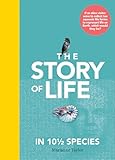The Story of Life in 10 1/2 Species
Material type: TextPublication details: Cambridge, Massachusetts : The MIT Press, 2020.Description: 256 pg; 24 cmISBN:
TextPublication details: Cambridge, Massachusetts : The MIT Press, 2020.Description: 256 pg; 24 cmISBN: - 9780262044486
- QH325 .T375
| Item type | Current library | Shelving location | Call number | Status | Date due | Barcode | Item holds | |
|---|---|---|---|---|---|---|---|---|
| Books | Asian University for Women Library | General Stacks | QH325 .T375 (Browse shelf(Opens below)) | Available | 031958 |
Browsing Asian University for Women Library shelves, Shelving location: General Stacks Close shelf browser (Hides shelf browser)

|

|

|

|

|

|

|
||
| QH324.2Z84 Understanding Bioinformatics | QH325.D38 The origin of life | QH325.D88 Origins of life. | QH325 .T375 The Story of Life in 10 1/2 Species | QH331.M375 What makes biology unique considerations on the autonomy of a scientific discipline | QH331.T45 The lives of a cell notes of a biology watcher | QH332.B5157 The bioethics reader editors' choice |
Souvenirs of the planet: Ten (and a half) life forms, each of which explains a key aspect of life on Earth.
If an alien visitor were to collect ten souvenir life forms to represent life on earth, which would they be? This is the thought-provoking premise of Marianne Taylor's The Story of Life in 10 and a Half Species. Each life forms explains a key aspect about life on Earth. From the sponge that seems to be a plant but is really an animal to the almost extinct soft-shelled turtle deemed extremely unique and therefore extremely precious, these examples reveal how life itself is arranged across time and space, and how humanity increasingly dominates that vision.
Taylor, a prolific science writer, considers the chemistry of a green plant and ponders the possibility of life beyond our world; investigates the virus in an attempt to determine what a life form is; and wonders if the human—“a distinct and very dominant species with an inevitably biased view of life”— could evolve in a new direction. She tells us that the giraffe was one species, but is now four; that the dusky seaside sparrow may be revived through “re-evolution,” or cloning; explains the significance of Darwin's finch to evolution; and much more. The “half” species is artificial intelligence. Itself an experiment to understand and model life, AI is central to our future—although from the alien visitor's standpoint, unlikely to inherit the earth in the long run.
There are no comments on this title.
